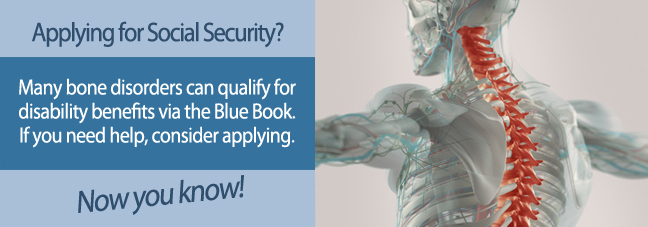The World Health Organization reports musculoskeletal conditions as the leading cause of severe chronic pain and disability in the world, and according to the United States Bone and Joint Health Initiative, these conditions affect more than half of America’s population. These impairments include everything from traumatic injuries and arthritis to spinal conditions like osteoporosis and back pain, all of which can potentially qualify for disability benefits.
Action Week Initiatives
The United States’ National Bone and Joint Health Action Week is part of a global initiative, with the purposes of increasing awareness among the public and focusing attention within the medical and political communities on musculoskeletal health and wellness. The action week occurs from October 12 through the October 20 annually, and incorporates five special days that draw even greater attention to specific impairments:
- World Arthritis Day – October 12
- World Spine Day – October 16
- World Trauma Day – October 17
- World Pediatric Bone and Joint Day – October 19
- World Osteoporosis Day – October 20

Cities, towns, companies, hospitals, and other organizations hold many free educational events throughout this week. Doctors, nurses, physical therapists, and other medical professionals additionally focus their attention on disease prevention, management, and treatment advancement topics throughout the week.
Social Security Disability and Bone and Joint Conditions
The Social Security Administration (SSA) lists a number of bone and joint impairments within its Blue Book, the manual of medical conditions that “automatically” qualify for disability benefits. Some of these listings appear in the Musculoskeletal Section, including joint dysfunction, spinal disorders, and traumatic injuries, like broken bones.
The SSA may review some bone and joint impairments under disability listings in other sections of the Blue Book, including the neurological and autoimmune sections. For example, they may review spinal conditions that cause nerve complications in the arms and legs under a neurological listing, while Sjögren's syndrome, lupus, and other inflammatory joint disorders appear in the immune system listings.
The SSA covers children’s bone and joint disorders in unique listings. These appear in Blue Book Part B, and include everything from musculoskeletal impairments to congenital disorders. There are likewise sections covering neurological and immune system disorders, and dependent upon a child’s medical condition, the SSA may review his or her disability application under a listing in one of these sections instead.
Getting Help with a Disability Claim and Submitting Your Application
Whether you’re applying for benefits for yourself or on behalf of a child with a bone or joint condition, you may wish to consider seeking legal assistance. An attorney can help you prepare your application and collect the evidence necessary to support your claim. If the SSA initially denies you benefits, a disability advocate or attorney can help file an appeal, and can represent your interests at the appeal hearing too.
Adults filing for SSDI benefits may complete and submit their applications online. An application appointment at the local SSA office is another option. For a child’s disability application though, you’ll need to file locally or over the phone, by calling 1-800-772-1213. The same is true if you’re applying for SSI for yourself, since an application interview is the standard process with this need-based, disability program.